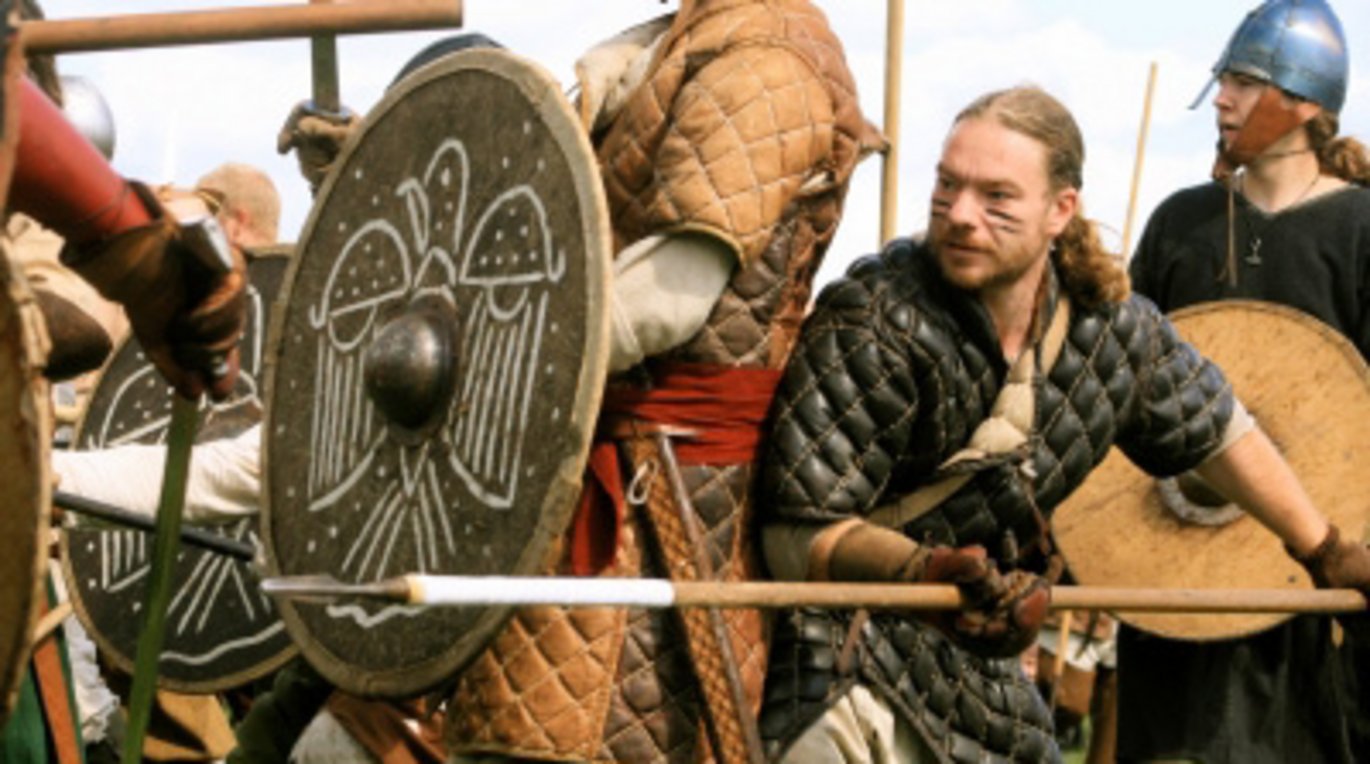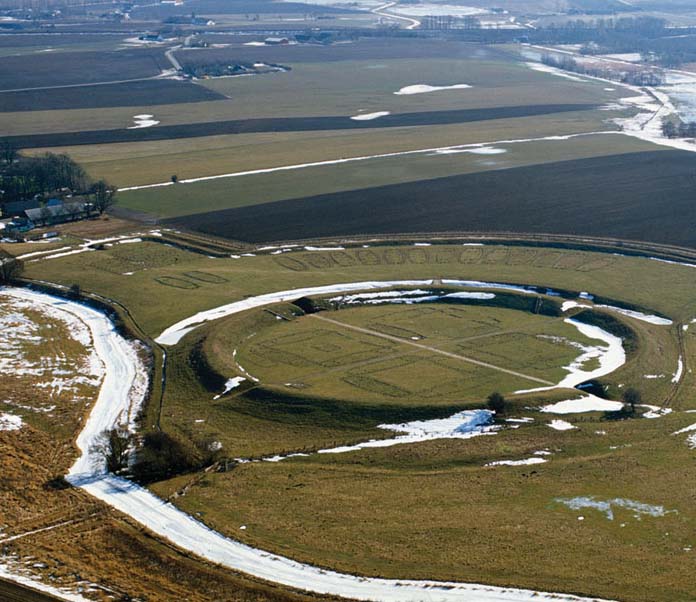Harold Bluetooth’s Vikings were Polish mercenaries
As part of an international team of researchers, archaeologists at Aarhus University can reveal that a large part of Harold Bluetooth’s Viking army consisted of foreigners – possibly from Poland.



The story of Harold Bluetooth, who converted the Danes to Christianity and unified the Kingdom of Denmark during the Viking Age, is one of the most archetypal Danish stories in existence. Bluetooth’s achievements are immortalised at places such as the rune stones in Jelling, which date from the tenth century.
It was previously believed that Harold Bluetooth’s Viking army mainly consisted of ‘native’ Danish solders. However, archaeologists from institutions including Aarhus University can document via analyses of skeletons found at the burial site at Trelleborg on the Danish island of Zealand that many of the soldiers – possibly more than half – were actually foreigners.
The circular fortress at Trelleborg was just one of a number of such fortifications (also called trelleborgs) built within a short space of time in different parts of Denmark in the late tenth century. They were presumably used as seats of power by Harold Bluetooth, especially during the war against his rebellious son Sweyn Forkbeard.
The team of researchers examined a total of forty-eight skeletons using a new method called strontium isotope analysis. This made it possible to determine that more than half of the skeletons did not come from Denmark. The researchers were not able to trace the precise geographical origin of the deceased, but previous finds of artefacts such as pottery and weapons around Trelleborg indicate that many of them came from Norway or south of the Baltic Sea – i.e. what is now Poland.
The results have just been published in the British journal Antiquity, which is one of the most prestigious archaeological journals in the world.
Birthplace determined by tooth enamel
Researchers from Aarhus University, the University of Copenhagen and the University of Wisconsin-Madison took samples of the skeletons’ tooth enamel and studied their content of isotopes of the element strontium.
The composition of strontium isotopes depends on the geological formations in the area, and the element can thus be used as a geographical indicator.
Strontium enters the human body via food and water, and subsequently settles in bones and tooth enamel. Here it leaves a kind of signature – just like a barcode for goods – because the strontium isotopes accumulate differently, according to the geological environment in which people grow up. While bones change throughout life, tooth enamel is formed in childhood and subsequently undergoes minimal changes only. An analysis of the strontium isotope composition in tooth enamel can therefore reveal whether the people buried at Trelleborg were of Danish origin or not.
Of the forty-eight skeletons analysed, thirty of which came from individual graves and the remainder from different mass graves, more than half did not come from Denmark.
One of the mass graves at the Trelleborg burial site contained a special surprise. The strontium isotope analysis showed that at least half of the men buried there came from different areas outside Denmark. All the dead were fully grown men and were buried with the same care that characterised the other graves at the site. A possible lesion on a thigh bone indicates an act of violence, although the deaths of the many men could also be due to other causes.
Mercenaries influenced the formation of the state
One of the researchers behind the sensational result is Dr Andres Siegfried Dobat, an archaeologist at the Section for Prehistoric Archaeology, Aarhus University. The new results confirm his hypothesis that foreigners influenced the formation of the national state of Denmark – not just during the time of Harold Bluetooth, but also in the centuries that followed.
He bases his theory on other sources, such as a rune stone from Egå that mentions Ketill the Norwegian. He was possibly a house-carl, i.e. a bodyguard for Harold Bluetooth.
Pottery of Slavic origin has also been found in the trelleborgs in different parts of Denmark.
The earliest historical sources dealing with the political situation in Denmark in the Viking Age – including Saxo Grammaticus – also mention foreigners in the armies of the early Danish kings.
In addition, a battle axe inlaid with silver and gold was found in one of the warrior graves at Trelleborg on the island of Zealand. Archaeologists presume that the warrior came from an area south of the Baltic Sea, possibly from the early Polish kingdom or from the fabled Jomsburg – a fortress thought to have been located on the south coast of the Baltic Sea.
According to Dr Dobat, there are indications that the foreigners were either part of a warrior elite or regular mercenaries, even though other possible explanations cannot be excluded regarding the large number of foreigners among the troops at Trelleborg.
Mercenaries are more loyal
The fact that Harold Bluetooth made use of ‘foreign workers’ in his army comes as no surprise to Dr Dobat.
“The noticeable presence of foreigners is possibly an expression of a very deliberate strategy that was used by the political elite in Viking Age Denmark. Many upheavals took place in Denmark during the tenth century. Societal conditions underwent radical changes, and a number of fundamentally new institutions were introduced: monarchy, the kingdom, military organisation, land ownership, market economy, coins and coinage economy, towns and cities, Christianity, and so on,” says Dr Dobat.
For Harold Bluetooth to accomplish such drastic changes, he had to depend on loyal supporters, and it was easiest for him to find them abroad. The foreigners were not expected to abide by the Viking society’s rules and common law, because they were not caught up in the kinship relations that otherwise characterised the traditional Viking society. Neither were they subject to the nobility, which – according to later written sources – was in opposition to Harold Bluetooth.
Other kings made use of a similar strategy, such as King David I of Scotland in the twelfth century and the Osman sultans in the fifteenth century.
Dr Dobat thus argues that the building up of the Danish state took place with significant outside help.
“As a result of my research, the formation process of the state in Denmark – or at least the Viking Age phase of this lengthy process – appears to depend in part on the activity and influence of people from abroad,” concludes Dr Dobat.
Read also
- Dobat, Andres Siegfried: The State and the Strangers: The Role of External Forces in a Process 65 of State Formation in Viking-Age South Scandinavia (c. AD 900–1050) in Viking and Medieval Scandinavia, no. 5, 2009
- Price, T. Douglas; Frei, Karin Margarita; Dobat, Andres Siegfried; Lynnerup, Niels and Bennike, Pia: Who was in Harold Bluetooth’s army? Strontium isotope investigation of the cemetery at the Viking Age fortress at Trelleborg, Denmark in Antiquity, no. 85, 2011, pp. 476–489
More information
- Andres Siegfried Dobat, farkado@hum.au.dk, (+45) 4111 8689, pure.au.dk
- Douglas Price, tdprice@wisc.edu (+45) 3142 2310